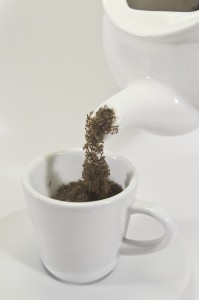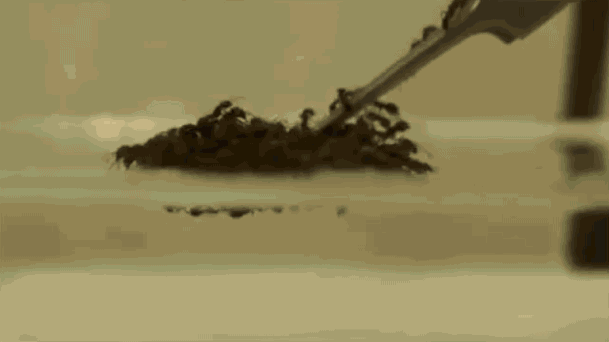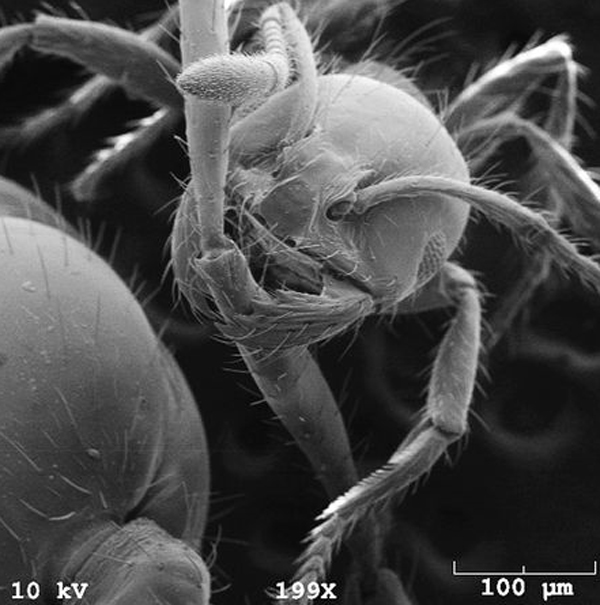Watch Fire Ants Use Their Bodies To Form Living Architecture
One species of ant can build floating rafts, resilient bridges and temporary shelters using nothing but their own bodies
/https://tf-cmsv2-smithsonianmag-media.s3.amazonaws.com/filer/ant-raft2.jpg)
When we think of ants as builders, we normally imagine them digging intricate tunnel networks as part of underground colonies.
But David Hu, Nathan Mlot and a team of other researchers at Georgia Tech are studying a very different type of building behavior specific to one ant species: The ability of Solenopsis invicta to construct bridges, rafts and even temporary shelters using their own bodies as building material.
“Fire ants are capable of building what we call ‘self-aggregations,’” Hu says. “They can build little boats, little houses called bivouacs and even bridges to cross streams by being the building material, linking their bodies together and forming strong networks.”
The ants are now considered an invasive species in 25 states, Asia and Australia, but their unusual behavior is a survival strategy shaped by their native environment: a particular area of wetlands in western Brazil that are flooded frequently. “The ants live underground, but when it begins to flood, they have to gather the colony members, pull them out of the ground and build a floating raft,” Hu says.
Fire ants form a living bridge between a cup and teapot. Photo courtesy of David Hu and Nathon Mlot/Georgia Tech
When this raft hits land, the ants keep building. To cross small streams during their subsequent migration, they make living bridges that allow the entire colony to scramble to safety. Afterward, using their bodies, they construct a temporary aboveground encampment to provide shelter for the few days it takes to re-dig underground tunnels. All the while, the ants that form the temporary shelter are continuously moving, but still preserving the structure. “It’s really living architecture—it has well-constructed, organized tunnels, brooding rooms,” Hu says. At least for the ants in the inside, this provides protection against hostile weather or predators.
Hu, an engineer, is primarily interested in studying the swarming ants as a novel material with unprecedented characteristics. As part of his group’s recent research, presented yesterday at an annual meeting of the American Physical Society, he and colleagues considered the ants within the context of other “active materials”—substances that can respond to changing conditions, such as self-healing cements that can use the energy in sunlight to expand and fill their own fractures.
“We wanted to characterize what kind of material it is—is it a fluid, or is it a solid, and how does it respond to stress?” he says. “In nature, for instance, these rafts might float down a river and bump into rocks, or raindrops might hit them.”
To test these self-aggregations, Hu’s team used a few techniques, comparing live ant structures to clumped dead ants as a control. Using a rheometer—a device that can precisely measure the stress response and flow of a fluid, and is often applied in industrial situations (such as the development of a new shampoo)—they found that the ants continuously reorganize their structure to maintain stability.
Many materials behave like a solid when stressed by forces moving at certain speeds, and a fluid when stressed by slowed ones. Water, for instance, behaves like a fluid when you stick your hand in it, but a solid when hit by a human body jumping off a diving board—the reason that a belly flop hurts so much.
But the ant structures are a combination of solid and fluid when stressed by forces at all speeds, the researchers found. They actively deform their structure to accommodate a stress (like a fluid) but then bounce back into place afterward (like a solid). Check out what happens when one of their structures is compressed by a petri dish, for instance:
“This makes sense, based on their natural environment,” Hu says. “If they’re floating in a raft down a river, they have no control over where it floats, so if there’s something in the way—say, a twig—you see respond and flow around the twig, kind of like an amoeba.”
The ants’ sheer resiliency and buoyancy is also remarkable. When the researchers tried to push the floating rafts below the water’s surface, they found they could resist a significant amount of force and float back up:
This is enabled, in part, by the ants’ exoskeletons, which are naturally hydrophobic (i.e. they chemically repel water). When many ants clump together to form a structure, water doesn’t penetrate into the gaps between then, so when they’re forced underwater, the air that remains in these cavities helps them float.
Perhaps the biggest mystery of these ants’ remarkable living structures is how the creatures communicate to build them. Most ant communication is based on trails of pheromones left on the ground, but in such an interconnected form, that type of communication seems unlikely. Microscopic examination reveals that the ants grasp each other using both their jaws and little claws on the end of their legs. Noting this, Hu adds, ”We think they’re communicating through touch, but we really don’t understand it yet.”
/https://tf-cmsv2-smithsonianmag-media.s3.amazonaws.com/accounts/headshot/joseph-stromberg-240.jpg)






/https://tf-cmsv2-smithsonianmag-media.s3.amazonaws.com/accounts/headshot/joseph-stromberg-240.jpg)